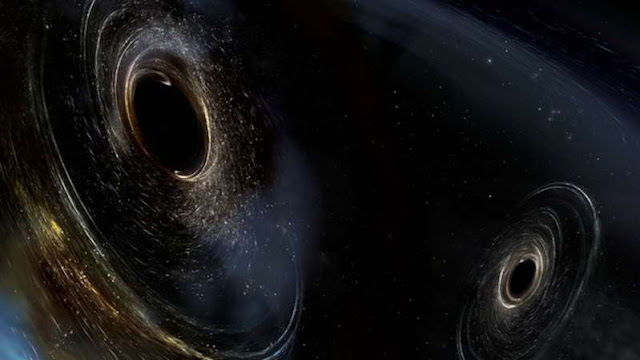 |
| An artist’s impression of two black holes as they’re in the process of merging. |
Researchers just announced the discovery of the most massive, distant black hole collision ever observed. Excitingly, the huge cosmic crash wasn’t alone. The discovery of three other black hole collisions were announced at the same time, bringing the total number of observed mergers of these incredibly dense regions of space to 10.
The discoveries were announced over the weekend at a scientific meeting in Maryland, where researchers gathered to talk about the latest research into gravitational waves. Gravitational waves are ripples in space-time that are usually caused by two objects rotating around each other. The strongest gravitational waves come from the collision of black holes or very dense objects called neutron stars.
The four latest additions to the small but mighty catalogue of gravitational wave-makers were all observed between July and August 2017. The first one, which was spotted on July 29th, was the largest and most distant ever recorded. Five billion light-years away from Earth, two black holes smashed together creating a black hole about 80 times as massive as our Sun.
Gravitational waves travel at the speed of light, so this giant crash took place 5 billion years ago, about hundreds of millions of years before our Solar System even existed. The combination of the two was so powerful, that the equivalent of the mass of five Suns was turned into gravity waves — waves that reached Earth on July 29th.
Scientists, including Albert Einstein, first proposed the idea of gravitational waves in the early 1900s, but researchers weren’t able to detect them until 2015. Researchers have to use huge observatories to detect gravitational waves and there are currently only a few of these detectors on Earth. The most recent discoveries were made by two detectors in the United States, called LIGO (Laser Interferometer Gravitational-Wave Observatory), and one in Europe, known as Virgo. We’re just learning about these four collisions now because, until recently, they were buried in data collected by the detectors. Researchers found the signals by sorting through and reanalyzing all the observations that the researchers collected during the last observing run.
LIGO and Virgo have starred in a few major discoveries since Virgo came online in August 2017, including the observation of colliding neutron stars which was announced last October. “In just one year, LIGO and VIRGO working together have dramatically advanced gravitational-wave science, and the rate of discovery suggests the most spectacular findings are yet to come,” Denise Caldwell, the director of the National Science Foundation’s Division of Physics said in a statement.
LIGO and Virgo haven’t made any observations since August 2017. In the downtime, researchers and engineers have kept busy by maintaining and upgrading the detectors in preparation for the next round of observations. LIGO’s third observing run is scheduled for early 2019, and Virgo, with freshly updated instruments, is expected to join in on the fun again.
Astrophysicists expect to find many more collisions during the next observational run, but they’re also looking forward to getting some new equipment in the next few decades. The European Space Agency and NASA are working together on a space-based observatory called the Laser Interferometer Space Antenna (LISA). LISA is made up of three spacecraft situated millions of miles apart. Its size and position in space mean that it will be able to detect gravitational waves that Earth-based detectors can’t. This summer, China also announced plans to build two space-based gravitational wave detectors.
All that activity means that these latest detections are just the beginning. LISA isn’t scheduled for launch until the 2030s, but researchers are already anticipating the next generation of detectors. Writing about the latest discoveries in The Conversation, Australian physicist David Blair noted that “With planned new detectors we anticipate 10 times more sensitivity. Then we expect to be detecting new signals about every five minutes.”



